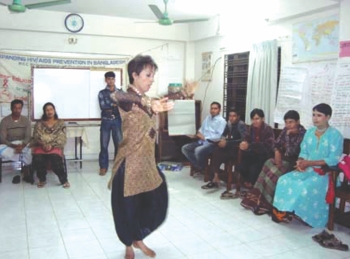Behind The Scene
Bogra
Bangladeshi Eunuchs Revered in India
Eunuchs, or more commonly known as Hijras in Bangladesh are migrating to India from Bogra for their wide acceptance and as their dance and singing is more accepted there. Groups of the Hijras are seen attending and hosting functions in places like Delhi and Kolkata, where each group is paid anything between fifty and eighty thousand rupees for each performance.
....................................................................................
Hasibur Rahman Bilu
 |
An Eunuch performing at an event in India |
While talking to Nur Alam, it was revealed that most of the Hijras of Shonatola, Dhonut Upazila, and the Bogra town were migrating to Kolkata and Delhi in India. Nur says that they are far more widely accepted there and that they had a better chance of making a living compared to in the country. Even though Alam has never taken part in any such performance of dacnce or song, Alam has attended many such programs. Nur Alam also said that there were at least eighty eunuchs from Bogra working in Delhi alone.
The three or four times that Alam has been to India, it was always felt that the Indian citizens are more accepting and respectful to the third gender. Indians in general support the start of a business. “I know for a fact that if a Hijra walks past the market in a sari in the morning, then the shopkeepers will provide whatever they can from their wallets and say, 'Mashi (maternal aunt), pray for our well being'”.
Some of these emigrants have accumulated enough wealth to have come back and build houses here in the country. Alam remebered one time that he was in India and had spent the night at Alivia's house. Alivia is a Hijra resident in India. Alam recalled that Alivia's house was very modern.
Speaking about the occasions the Hijra's sing and dance in, Alam said they usually stick to weddings and child birth ceremonies. Most of their performances are during the day. Wedding functions are celebrated with dance and songs from Hindi movies and popular numbers in the Hindu culture, whereas the dances are different during ceremonies for new-borns. The Hijras in India follow a very strict code, diverting from which a member of the community can be fined up to fifty thousand Rupees. Alivia is one of the leaders in India of the many Hijra communities and supposedly leads at least three hundred Hijras. Diba nd Imon are part of Alivia's group of Hijras. Nur Alam thinks that each Hijra in that community makes around seven hundred Rupees daily.
The Hijras travel to India before the Pujas, as the income generation is highest during the Hindu festivals.
A private company and institution based in Bogra: Light House headed by Harun Ur Rashid has taken up the initiative to work towards human rights, and the mental and physical health of Hijras there. Harun said, through the organizations work, at least thirty Hijras have migrated to India from Natore.
Copyright
(R) thedailystar.net 2011
|

